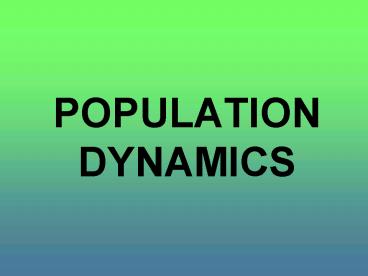POPULATION DYNAMICS - PowerPoint PPT Presentation
1 / 18
Title:
POPULATION DYNAMICS
Description:
Small populations are susceptible to disease, predation, or natural catastrophes ... a Type II survivorship curve are coral, squirrels, honey bees and many reptiles. ... – PowerPoint PPT presentation
Number of Views:53
Avg rating:3.0/5.0
Title: POPULATION DYNAMICS
1
POPULATION DYNAMICS
2
Populations are dynamic
- Size
- Density
- Dispersion
- Age distribution
3
Population size
- Small populations are susceptible to disease,
predation, or natural catastrophes - Large populations are prone to starvation or
disease
4
Population density
- Ecological population density is more useful than
population density
5
Population dispersion
- Clumping (grazing animals, schools of fish,
flocks of birds, and troops of baboons) - Uniform dispersion (rare in nature, but may occur
in situations like creosote bushes or sea
urchins) - Random dispersion
6
Age structure
- Prereproductive
- Reproductive
- Postreproductive
7
Population change
- Births
- Immigration
- Deaths
- Emigration
8
Biotic (reproductive) potential
- Maximum rate of reproduction is determined by
when a species can first reproduce, how long each
generation is, how long they can reproduce and
how many offspring they produce each time.
9
Growth curves
- J-shaped curves
10
Growth curve j shaped
11
Density - Dependent Population Controls
- Competition for resources
- Predation
- Parasitism
- Disease
12
Density Independent Population Controls
- Floods
- Hurricanes
- Severe drought
- Fire
- Destruction of habitat
- Pesticide spraying
13
Reproductive Strategies
- R-strategist species
- K-strategist species
14
K reproductive strategy
Brooders - "K-selection", have fewer offspring
but invest more time and resources in insuring
survival, both in gestation and rearing.
15
R- reproductive strategy
- Spawners - "r-selection", have numerous offspring
to overwhelm the odds. This means that few
resources and minimal energy are invested in the
survival of each individual.
16
Survivorship curves
- Type I survivorship curves are for species that
have a high survival rate of the young, live out
most of their expected life span and die in old
age. Humans are a good example of a species with
a Type I survivorship curve.
17
Type II survivorship curves are for species that
have a relatively constant death rate throughout
their life span. Death could be due to hunting or
diseases. Examples of species exhibiting a Type
II survivorship curve are coral, squirrels, honey
bees and many reptiles.
18
Type III survivorship curves are found in
species that have many young, most of which die
very early in their life. Plants, oysters and sea
urchins are examples of species that have Type
III survivorship curves.































